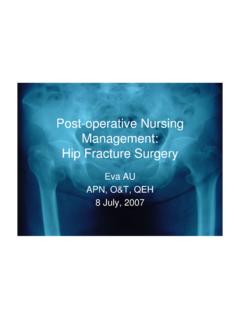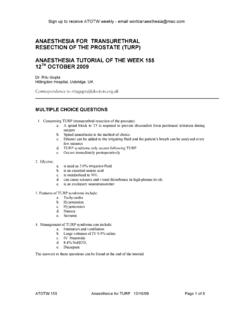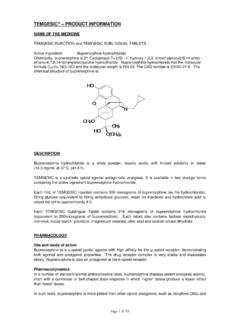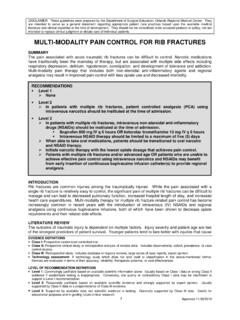Transcription of An evidence-based approach to the preoperative evaluation ...
1 An evidence- based approach to the preoperative K. Jafferand Bindu Sangani. Primary Care Reports (Oct 2004): p111(16). (11071 words) Full Text:COPYRIGHT 2004 A Thomson Healthcare Company Each year, more than 36 million surgical procedures are performed in the United States. (1) Approximately one-third are performed in patients older than 65 years. (1) This subset of the population also is the fastest growing, with estimates that by 2030 this population will double from 35 million to 70 million people and will account for 20% of the American population. (2) A recent prospective cohort study done at a major academic center showed that elderly patients have a higher rate of major perioperative complications and mortality after noncardiac surgery compared to their younger counterparts.
2 (3) Complications occur frequently, and cardiovascular events are the leading cause of perioperative death. (4) The cost of perioperative cardiovascular morbidity alone is approximately $20 billion in the United States. (5) Therefore, a preoperative evaluation , especially in the elderly and the young with medical problems, is needed. This evaluation should be geared toward risk assessment and implementation of risk reduction therapies that help decrease perioperative morbidity and mortality, thereby decreasing associated cost. In addition, the Joint Commission on Accreditation of Healthcare Organizations (JCAHO) requires all surgical patients to have a history and physical exam documented in the medical record in the 30 days prior to their surgery.
3 --The Editor Introduction More and more surgeries are being performed in which patients are admitted and discharged the same day the procedure is completed. For most major elective surgeries, the patient is admitted on the morning of the procedure, allowing minimal time for the anesthesiologists to perform any type of risk assessment. At that point, it may be too late to implement many risk reduction strategies, so they must rely on one of the following models or providers to perform the preoperative evaluation : 1. Traditional preoperative Assessment Model. The surgeon, the resident, nurse practitioner (NP), or physician assistant (PA) working on the surgical team performs this assessment. This approach often may rely on multiple consultants, a "shotgun approach to testing," and sometimes patients may be admitted to the hospital one or more days prior to surgery.
4 In the era of managed care and cost containment, admission to the hospital to conduct preoperative testing has become obsolete. (6) 2. Preanesthesia Testing (PAT) Clinic Model. based at the hospital, an NP, PA, or nurse anesthetist sees patients under the supervision of an anesthesia staff. This service is provided at no additional cost to the patient as the preoperative anesthesiology fee is bundled into the diagnosis related group (DRG). These clinics have been shown to decrease costs related to effective use of testing and a decreased cancellation rate but are associated with an initial start-up cost and an annual cost to run. (6-8) In addition, these clinics may not be able to handle complex medical and elderly patients.
5 Page 1 of 27 General OneFile Print10/24/2007 preoperative Clinic Staffed by Internists. A few institutions across the country have such a model, which is based at the hospital. One such clinic, the Internal Medicine preoperative Assessment Consultation and Treatment (IMPACT) Center, has been in place since 1997 at the Cleveland Clinic. The IMPACT Center, as part of a unique preoperative evaluation model, has decreased surgical delay rate by 49%, and has decreased significantly the cost of evaluation by the anesthesiologists in their clinic, allowing them to concentrate on anesthesia-related issues such as the choice of anesthetic, airway assessment, prior anesthetic events, patient directives, and postoperative pain control.
6 (9) During the preoperative evaluation conducted by the internist, the goal is not to clear patients for surgery, but more importantly, to prepare them for surgery. Each patient undergoes a thorough but focused history and physical exam aimed at medical risk assessment, perioperative medication management, implementation of prophylactic therapies such as beta-blockers, optimization of existing chronic medical conditions, and further testing if necessary. The consultation ends with a typewritten electronic communication that is available to all practitioners involved in the patient's care. Finally, all recommendations are discussed in person with the patient. 4. Primary Care Physician (PCP) Model. This is probably the most commonly used model in which the patient's family physician, internist, or cardiologist performs the preoperative evaluation at the request of the patient's surgeon as a medical consultation.
7 It is, therefore, important for these physicians to be well versed in the nuances in perioperative medicine as well as to understand the issues faced by anesthesiologists and surgeons in planning and performing a surgical procedure. It is key that the evaluating physician communicate with the surgical team and implement clear strategies to maximize the patient's medical status. The goals of this article are to provide internists and family physicians with a detailed, up-to-date review of this topic with a special emphasis on the various components of a preoperative evaluation . Goals of the preoperative evaluation The preoperative evaluation serves not to clear patients for surgery but rather to perform a comprehensive evaluation during which the consultant should outline the pertinent risks, medical conditions, and a plan to optimize medical care.
8 The following step-wise approach is recommended for a preoperative evaluation : 1. Conduct a detailed history with a review of systems focused to documenting established disease and uncovering new disease or risk factors that will impact the perioperative complication rate. By incorporating validated risk assessment tools in the evaluation , overall risks for certain complications can be determined. For example, cardiac risk assessment tools, such as the Lee Cardiac Risk Index (see Table 1), may help to assess the overall risk of a cardiac event. Pulmonary risk assessment tools (see Table 2) may help to determine the overall risk of postoperative respiratory failure or pneumonia. The delirium prediction rule (see Table 3) can help to predict the risk of postoperative delirium, and a venous thromboembolism (VTE) risk assessment tool (see Table 4) can help to predict the risk of post-operative VTE with suggested prevention strategies.
9 2. Assess the patient for signs and symptoms of occult cardiac or pulmonary disease that may impact surgery ( , aortic stenosis or asthma). 3. Estimate the patient's functional status using the Duke Activity Status Index. (See Table 5.) 4. Evaluate the surgery-specific risk that is directly related to the type of the procedure. For Page 2 of 27 General OneFile Print10/24/2007 , the surgery related risk from the repair of an abdominal aortic aneurysm is high, and the risk related to cataract surgery is minimal. (See Table 6.) 5. Determine if preoperative laboratory or diagnostic tests are needed. 6. Review the patient's medications, including prescribed, over-the-counter, and herbal, and determine their necessity perioperatively.
10 7. Implement risk reduction therapies or recommendations for post-operative use ( , beta-blocker therapy, treatment of active bronchitis, VTE prevention strategies, etc.). (See Tables 4 and 7.) 8. Assess if the patient has any special perioperative needs, such as the need for subacute bacterial endocarditis (SBE) prophylaxis (see Table 8) or stress dose steroids. (See Table 9.) 9. Optimize all medical conditions preoperatively. 10. Provide appropriate postoperative medical follow-up. At the conclusion of this evaluation , it is important for the clinician to communicate his or her recommendations to the patient, surgeon, and anesthesiologist, especially with regard to medication adjustments in preparation for surgery, the perioperative risk, and strategies for risk reduction.







